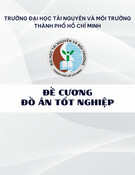
MINISTRY OF EDUCATION
AND TRAINING
MINISTRY OF AGRICULTURE
AND RURUAL DEVELOPMENT
THUYLOI UNIVERSITY
DAO TAN QUY
BUILDING A NUMERICAL MODEL SIMULATING
WATER FLOW AND SEDIMENT TRANSPORT IN SMALL
AND MEDIUM WATERSHEDS
Specialization: Hydrology
Code no: 62 44 90 01
SUMMARY OF DOCTORAL THESIS
HA NOI, 2017

This scientific work has been accomplished at: ThuyLoi University
Advisor 1: Assoc.Prof. Dr. Pham Thi Lan Huong
Advisor 2: Assoc.Prof. Dr. Ngo Le Long
Review No.1: Assoc.Prof. Dr. Nguyen Ba Quy
Review No.2: Dr. Nguyen Lap Dan
Review No.3: Assoc.Prof. Dr. Nguyen Hoang Son
This Doctoral Thesis will be defended at the meeting of the University Doctoral
Committee at:
................................................................................................................................
................................................................................................................................
at …………..on……………
This thesis is available at:
- The National Library
- The Library of Thuyloi University

1
INTRODUCTION
1. Problems statement
In recent years, under the negative impact of natural factors as well as the
global climate change have caused erosion, sediment transport and land
degradation in watersheds, especially inhillslopes.
Vietnam is situated in the region of tropical monsoon climate with mountains
account forabout 3/4 of the total area, hence erosion is considered as a major
threat to the earthen slopes in Vietnam.If we do not have measures to prevent
erosion, hundreds of tons of soil and nutrients are lost every year leading
tolands become degraded and can no longer cultivated.
Therefore, the “building numerical model to simulate the flow and sediment
transport on small and medium watershed” is necessary and urgent to apply in
calculating the flow and sediment transport on Vietnam’s watersheds.
2. Objectives
- Research on the scientific basis to a construct numerical model to simulate the
flow and sediment transport on watershed.
- Application of the built numerical model in some small and medium
watersheds.
3. Objects and Scope
- Objects of the study: The numerical models simulating flow and sediment
transport.
- Scope of the study: Small and medium watersheds.
4. Study contents
- Provide an overview of the numerical models simulating erosion and sediment
transport in the medium and small watersheds in the world as well as in
Vietnam, then evaluate the technical limitation and point out the issues that the
thesis should concentrate.
- Apply the theoretical basis of the mechanism of erosion and sediment
transport to develop anumericalmodel simulating erosion and sediment
transport in small and medium watersheds.
- Apply the developed numerical model to some small and medium watersheds

2
in Son La province.
5. Methodology
- Literature review;
- Studying on the basic theory and inheriting other related studies;
- Remote sensing and Geographic Information System (GIS);
- Mathematical Modelling;
- The study results were reported and discussed in many conferences.
6. Implications
Scientific significance: The research results of this thesis will reconfirm that
buildingnumerical models simulating sediment transport applying remote
sensing and GIS is very effective and necessary in the present period.
Practical significance: The results of this thesis will provide local data sources
and tools that can monitor, evaluate, look up information and monitoring the
impact of erosion and sediment transport to the activities of exploitation and
using land and water, thenprovideperfectly reasonable solutionsfor water resource
planning, and for land use planning.
7. New contributions
- Construction of a new numerical model simulating the flow and sediment
transport on small and medium watershedsthat usesLax-Friedrich Scheme and
addsmore elements of time and space to it to solve flow and sediment transport
equation.
- Construction of the correlation equationbetweenthe resultsof inter-rill erosion
and rill erosion that can predictthe amount of sediment eroded and transported
in watershedsbased on the intensity of rainfall.
8. Contents: The thesis consists of 3 main chapters
Chapter I:Overview of models simulating sediment transport in small and
medium watershed.
Chapter II:The scientific basis to develop a numerical model simulating
sediment transport in small and medium watersheds.
Chapter III: Application of the developed numerical model to simulate flow
and sediment transport in several small and medium watersheds.

3
CHAPTER 1 OVERVIEW OF MODELS SIMULATING SEDIMENT
TRANSPORT IN SMALL AND MEDIUM WATERSHED
1.1 Overview of erosion and sediment transport inwatershed
1.1.1 Definitions and basic concepts
1.1.1.1 Watershed erosion
Erosion is a phenomenon where piece elements, clods, and some time the
whole land surface to be eroded and transported away by the wind and water
power.
Water erosion depends on the energy of the water flow and the resistance to
erosion of the soil where water flows.
1.1.1.2 Sediment and deposition
Suspended sediment is small-sized sediment particles floatingand driftingdown
in the water. The speed of it equals the speed of water flow.
Deposition is a process where the soil particles detached by erosion then
deposited in the ground or inside the water such as lakes, streams and wetlands.
1.1.2 The main causes of erosion and factors affecting erosion
1.1.2.1 The main causes of erosion
a. Group of rainfall factors: Rainfall, rainfall intensity and distribution
will decide to the forces dispersing the particles of soil, to the amount of water
and to the velocity of runoff. Rainfall in a short time will limit erosion due to
the insufficiency of water to form flow. When it rains with a greatintensity in a
long time, the very serious erosion will occur.
b. Group of soil mechanical component factors: For soil with heavy
mechanical components, the particles of soil are always small, smooth, cohesive
and hard to break up, thus the risk of erosion is low. For soil with medium
mechanical components, the particles of soil have moderate size and links, and to
be porous, hence it is easy to be eroded by surface runoff. Therefore, the risk of
erosion is high. For soil with light mechanical components, although having
unstable structure but it has a large particle size that is difficult to transport, thus
the erosion risk is not high. This soil has good permeability but bad water
retention.
1.1.2.2 The factors affecting erosion
There are 5 main factors affecting soil erosion include topography, soil type,


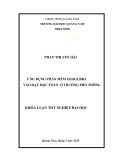

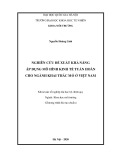
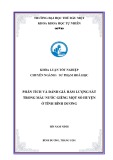
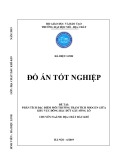
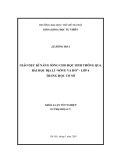
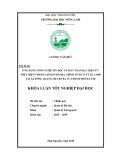
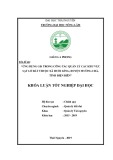

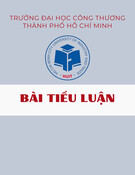
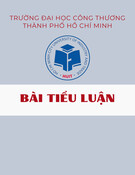
![Ô nhiễm môi trường không khí: Bài tiểu luận [Nổi bật/Chi tiết/Phân tích]](https://cdn.tailieu.vn/images/document/thumbnail/2025/20251011/kimphuong1001/135x160/76241760173495.jpg)
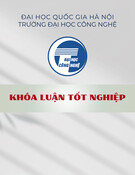
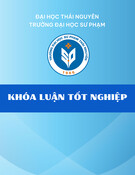
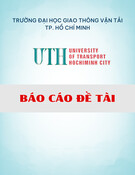




![Ứng dụng kỹ thuật trao đổi ion trong điện phân: Bài tiểu luận [chuẩn nhất]](https://cdn.tailieu.vn/images/document/thumbnail/2025/20250829/sonphamxuan1808/135x160/97341756442892.jpg)
